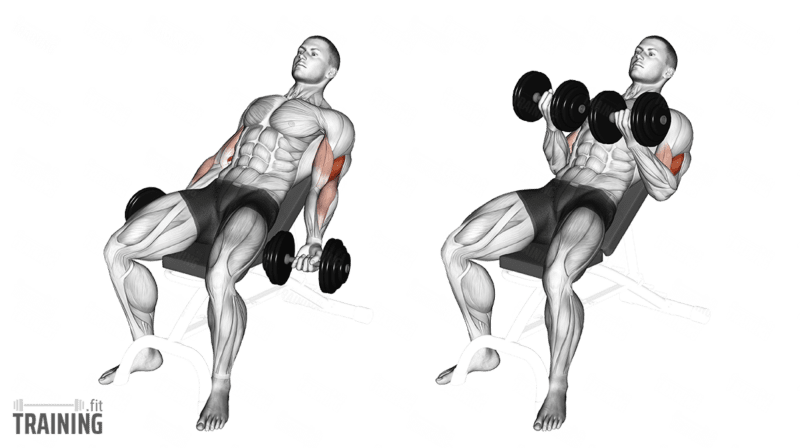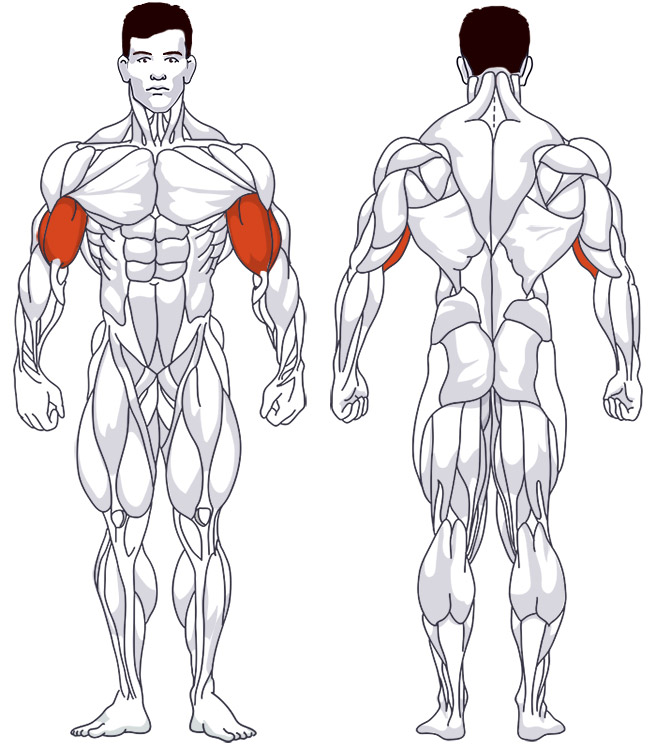Incline Dumbbell Biceps Curls
Isolation exercise, Free weightsOverview

Main muscles
- Biceps: Arm flexor
(Musculus biceps brachii) - Upper arm: Coracobrachialis muscle
(Musculus coracobrachialis)
Training plans
Here you can find example plans for incline dumbbell biceps curls training:
Incline Dumbbell Biceps Curls: Basics and alternatives

Involved main muscle groups:
Incline Dumbbell Biceps Curls
Incline bicep curls are a popular variation of the well-known fitness exercise. The main difference is in the body posture. Instead of standing (or sitting) upright, you sit on an incline bench and lean back, so your upper body rests on the backrest. The rest of the movement is identical to regular bicep curls: You let your outstretched arms hang down by your sides and then bend both arms at the elbow upwards.
Don’t confuse this exercise with incline Scott curls. In that exercise, you stand behind the incline bench and support your arms on the backrest for better isolation. An alternative is the Scott curls on the machine. There are also other ways to perform bicep curls, like with a barbell or on the cable machine.
Correct Execution
An advantage of incline dumbbell biceps curls is the slight stretching of the upper arms due to the larger angle between the upper body and upper arms. This increases the training intensity of the biceps and allows for better isolation.
There’s no exact rule for the backrest angle. Adjust it so that you can let your arms hang down straight without feeling any strain on your shoulders. As a rule of thumb (depending on the weight bench), one to two steps before the 90-degree setting should be enough.
Video Tutorial
Step-by-Step Instructions
Grab dumbbells in both hands.
Sit on the incline bench seat with an upright body.
Lean your upper body back. Your back and head should touch the backrest.
Let your arms with the dumbbells in your hands hang down to the sides. Turn your palms forward (underhand grip). You’re now in the starting position.
Bend your arm at the elbow and lift the weight up. Aim to move the dumbbells towards your shoulders. Important: Don’t move your shoulders during this motion. The upper arm shouldn’t change its position.
Once at the top, hold the weight briefly, then lower it in a controlled manner back to the starting position.
Common Mistakes
A typical mistake involves moving the shoulder. It’s important to keep your upper arm in the starting position, always pointing downward throughout the exercise. Avoid moving the arm over the shoulder forward, as this reduces tension and the advantage of incline dumbbell biceps curls. The weight movement should only come from the elbow.
Also, steer clear of the classic swing. On one hand, it leads to the previously mentioned error; on the other hand, it reduces the training stimulus due to the lower weight. Additionally, uncontrolled swinging, especially with heavier weights, increases the risk of injury. Because the shoulder is inclined backward due to the inclined position of the upper body, a swinging movement can quickly become problematic.